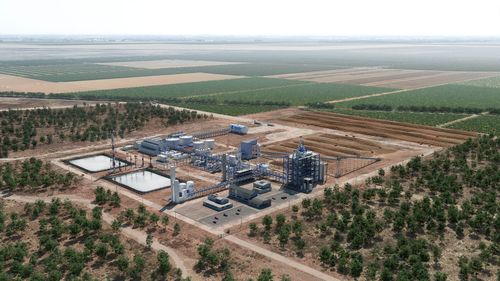The “Pathways to Commercial Liftoff: Sustainable Aviation Fuel” report from the D.O.E. Loan Programs Office outlines a comprehensive roadmap for scaling up Sustainable Aviation Fuel (SAF) production to meet the SAF Grand Challenge, which aims to enable substantial decarbonization of the aviation sector.
Aviation accounts for about 3% of total U.S. greenhouse gas (GHG) emissions, and without substantial decarbonization efforts, emissions are expected to double by 2050 due to growing air travel demand. SAF is the only viable near-term option to reduce emissions substantially, as alternatives like hydrogen and electric aircraft are not ready for widespread use and are suitable only for short-haul flights.
The SAF Grand Challenge aims to produce 3 billion gallons of SAF annually by 2030, covering 10% of U.S. jet fuel demand, scaling to 35 billion gallons annually by 2050, representing 100% of U.S. jet fuel demand.
SAF must achieve at least a 50% reduction in lifecycle emissions compared to conventional jet fuel to qualify under the SAF Grand Challenge. As of 2024, the U.S. has only four operational SAF production facilities, with a collective capacity of 64 million gallons per year. Significant expansion is needed, requiring 8-12 new commercial-scale facilities, each with a capacity of about 100 million gallons per year by 2030.
1. Policy and Incentive Risks
- Expiration of Federal Tax Credits:
- Current Situation: The Inflation Reduction Act (IRA) introduced significant tax credits to support SAF production. Specifically, the SAF Production Tax Credit (40B) is set to expire at the end of 2024, and the Clean Fuel Production Tax Credit (45Z) will expire in 2027. These tax credits have been instrumental in lowering the cost of SAF production and making SAF more competitive with fossil jet fuel.
- Risk: If these credits are not extended or replaced with equivalent incentives, there could be a major financial setback for SAF producers. The expiration of these credits would likely increase the cost of SAF relative to fossil fuels and renewable diesel (RD), leading to reduced investment in SAF projects and possibly causing some projects to be delayed, scaled down, or canceled.
- Impact: The uncertainty surrounding the future of these tax credits creates a challenging investment environment. Without long-term certainty, investors and developers may hesitate to commit resources to SAF projects, which typically require large upfront capital investments and have long payback periods.
- Preference for Renewable Diesel (RD) Over SAF:
- Comparative Advantage of RD: RD, a biofuel that competes with SAF for similar feedstocks (e.g., fats, oils, and greases), has a more favorable cost structure and is incentivized similarly to SAF under many federal and state programs. RD is easier to produce and often more profitable because it has lower production costs and can generate similar environmental benefits.
- Incentive Structures: Federal and state-level incentives, such as the Low Carbon Fuel Standard (LCFS) in California, do not differentiate between RD and SAF, which means producers might opt to produce RD over SAF. This situation is particularly problematic because RD is used primarily in ground transportation, while SAF is crucial for decarbonizing the aviation sector.
- Risk: If the existing incentives continue to favor RD over SAF, it will be challenging to scale up SAF production to meet the Grand Challenge targets. Producers may prioritize RD over SAF, especially when facing feedstock limitations or when there are higher returns from RD production.
2. High Production Costs and Economic Challenges
- SAF’s Cost Premium: SAF remains significantly more expensive than fossil jet fuel, with costs ranging from two to ten times higher, depending on the production pathway. Even the most mature SAF production technology, HEFA (Hydroprocessed Esters and Fatty Acids), is projected to remain at a price premium.
- Short-term and Low-volume Demand: Airlines operate on thin profit margins and often cannot afford the SAF premium without external subsidies or support. Many existing offtake agreements are short-term and low-volume, which does not provide the long-term financial security needed for large-scale SAF production investments.
- Financial Risk for Developers: Due to the high upfront investment costs and uncertain demand, SAF developers face significant financial risks. Without consistent, long-term incentives, SAF projects may struggle to secure the necessary financing or might require higher-risk premiums from investors, further complicating project economics.
3. Feedstock and Technology Risks
- Feedstock Limitations: The primary feedstocks for the HEFA pathway—fats, oils, and greases (FOGs)—are limited and face competition from other biofuel industries, such as RD production. As SAF production scales, the availability and cost of these feedstocks could become major constraints.
- Technological Maturity: While HEFA is the most commercially ready SAF production pathway, other promising technologies (e.g., Alcohol-to-Jet and Power-to-Liquid) are still in the development or early commercialization stages. These newer technologies will be essential for scaling SAF production beyond 2030, but they face technical and financial hurdles that could delay their deployment.
4. Demand-side Challenges
- Lack of Long-term Offtake Agreements: Airlines and corporate buyers are hesitant to commit to long-term SAF offtake agreements because of price volatility and evolving carbon regulations. This hesitancy creates uncertainty for SAF developers and makes it difficult to secure project financing.
- Insufficient Market Mechanisms: Current market mechanisms do not fully value the environmental benefits of SAF, such as reduced lifecycle emissions and lower contrail formation. This lack of valuation makes SAF less attractive compared to cheaper carbon abatement options, like renewable diesel or direct air capture (DAC) credits.
5. Infrastructure and Supply Chain Risks
- Blending and Distribution Constraints: The existing infrastructure for blending, storing, and transporting SAF is limited. Building the necessary infrastructure to support widespread SAF adoption will require significant investment, and delays in infrastructure development could bottleneck SAF deployment.
- Regulatory and Permitting Delays: SAF projects must navigate complex regulatory and permitting processes, which can cause significant delays. Streamlining these processes is essential to ensure that new SAF production facilities can come online in a timely manner.
Summary of Critical Actions Needed
- Extending and Expanding Incentives: Policymakers need to extend the SAF-specific tax credits beyond 2027 and consider new incentives that explicitly favor SAF over other biofuels like RD.
- Creating Demand-side Incentives: Establishing SAF mandates or implementing carbon pricing mechanisms that reflect SAF’s full environmental value could help secure long-term offtake agreements.
- Developing Alternative Feedstocks: Investments in R&D for new feedstocks and technologies are necessary to reduce dependency on limited resources like FOGs and to scale up more sustainable production pathways.
- Streamlining Regulatory Approvals: Simplifying the regulatory environment for SAF projects could accelerate the scale-up and reduce barriers to investment.








